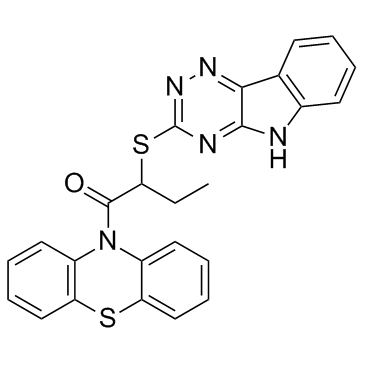309271-94-1
| Name | 10-[2-(5H-[1,2,4]triazino[5,6-b]indol-3-ylsulfanyl)butanoyl]-10H-phenothiazine |
|---|---|
| Synonyms |
10-[2-(5H-[1,2,4]triazino[5,6-b]indol-3-ylsulfanyl)butanoyl]-10H-phenothiazine
1-Butanone, 1-(10H-phenothiazin-10-yl)-2-(5H-1,2,4-triazino[5,6-b]indol-3-ylthio)- 1-(10H-Phenothiazin-10-yl)-2-(5H-[1,2,4]triazino[5,6-b]indol-3-ylsulfanyl)-1-butanone Inauhzin |
| Description | Inauhzin is a dual SirT1/IMPDH2 inhibitor, and acts as an activator p53, used in the research of cancer. |
|---|---|
| Related Catalog | |
| Target |
SIRT1 MDM-2/p53 IMPDH2 |
| In Vitro | Inauhzin (10 µM) induces p53 levels as effectively as actinomycin D (10 nM), and mediates p53-dependent cytotoxicity through its specific functional groups in human lung carcinoma H460 cells. Inauhzin (2 µM) induces p53 level and activity as well as p53-dependent apoptosis. Inauhzin also stabilizes p53 and inhibits its ubiquitylation. Inauhzin induces acetylation of p53 in H460 cells, but not tubulin, which is affected by knockdown of SIRT1[1]. Inauhzin (0-2 µM) significantly enhances the expression level and activity of p53 in HCT116p53+/+ cells and enhances the expression level and activity of p53 in H460 cells in a dose-dependent manner. Inauhzin and Nutlin-3 demonstrate synergistic cytotoxicity in the Nutlin-3 low-sensitive cells. Inauhzin and Nutlin-3 synergistically induce p53-dependent apoptosis[2]. Inauhzin targets both SirT1 and IMP dehydrogenase 2 (IMPDH2), and acts as a potent p53 activator[3]. |
| In Vivo | Inauhzin (30 mg/kg, i.p.) effectively induces apoptosis and suppresses tumour growth of H460 xenograft harbouring p53[1]. Inauhzin (30 mg/kg, i.p.) reduces the HCT116 tumor volume by appr 70%. Inauhzin (15 mg/kg) in combination with 150 mg/kg of Nutlin-3 demonstrates a significant synergy on p53 induction, apoptosis and tumor suppression of HCT116p53+/+ xenografts[2]. |
| Cell Assay | The cell counting kit is used to assess cell growth. Cell suspensions are seeded at 5000 cells per well in 96-well culture plates and incubated overnight at 37°C. Compounds are added into the plates and incubated at 37°C for 72 h. Cell growth inhibition is determined by adding WST-8 at a final concentration of 10% to each well, and the absorbance of the samples is measured at 450 nm using a Microplate Reader[1]. |
| Animal Admin | Five-weeks-old female SCID mice are housed in a BSL2 environment. Mice are subcutaneously inoculated with 5×106 H460 or 3×106 HCT116 cells. Tumour growth is monitored every other day with electronic digital calipers in two dimensions. Tumour volume is calculated with the formula: tumour volume (mm3) = (length × width2)/2. When the mean tumour volume reaches approximately 100 mm3 after 7-9 days, animals are dosed by i.p. injection with vehicle (5% DMSO) or Inauhzin. Inhibition of tumour growth is calculated on the last day of treatment. To detect p53 activation in vivo, tumours are harvested and disrupted in RIPA buffer containing a protease inhibitor mixture. Tumour lysates are analysed by IB. Cell proliferation in tumours is assessed by BrdU labeling followed by Immunostaining. 200 mg/kg body weight of BrdU is administrated to mice via i.p. injection 2 h before mice are sacrificed. Apoptosis is examined by TUNEL staining, using the Fluorescein In situ cell death detection kit[1]. |
| References |
| Density | 1.5±0.1 g/cm3 |
|---|---|
| Boiling Point | 773.6±70.0 °C at 760 mmHg |
| Molecular Formula | C25H19N5OS2 |
| Molecular Weight | 469.581 |
| Flash Point | 421.7±35.7 °C |
| Exact Mass | 469.103088 |
| LogP | 5.18 |
| Appearance | light yellow solid |
| Vapour Pressure | 0.0±2.7 mmHg at 25°C |
| Index of Refraction | 1.816 |
| Storage condition | -20℃ |
| Symbol |

GHS06 |
|---|---|
| Signal Word | Danger |
| Hazard Statements | H301 |
| Precautionary Statements | P301 + P310 |
| RIDADR | UN 2811 6.1 / PGIII |
